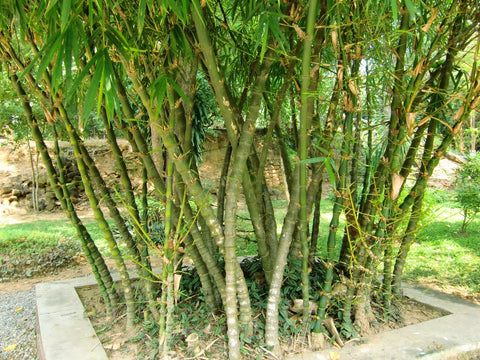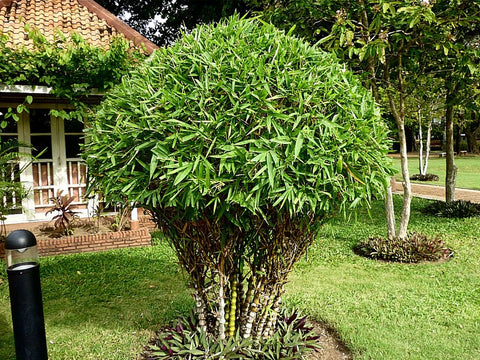What Are The Types of Buddha Belly Bamboo?
As many of you probably know already, there are hundreds of different bamboo species throughout the world. Most of the time you will have a ‘main’ species, such as Buddha Belly bamboo, in addition to having various sub-species or types. This means that while the main plant’s characteristics or basic requirements are the same, other characteristics will differ, such as leaf color, stem color or growth rate.
So what are the types of Buddha Belly Bamboo? Read more to find out…

Main Characteristics Of Buddha Belly Bamboo
Buddha Belly Bamboo is scientifically known as Bambusa Ventricosa. This species is perfect for growing outdoors, or as a bonsai or indoor plant. However, one of its best advantages is its ability to adapt to a wide range of growing conditions.
Buddha Belly bamboo was named for the plant’s characteristic tendency to have bulging culms, or to ‘belly out’. In order to make it belly out, this plant needs to be stressed for water. Many people have made an art of carefully starving this bamboo in order to achieve maximum ‘belly’ results.
This bamboo does best outdoors in full sun, however, its adaptable nature also makes it capable of being grown indoors. This bamboo has been known to survive temperatures below 20° F, as well as a range of soil conditions. Outside, under optimal conditions, this plant has been known to reach as much as 55 feet tall. However, when kept as a potted plant, its vertical growth is limited. Buddha Belly Bamboo is strong, adaptable and fast growing, possibly even one of the fastest growing species of bamboos.
Giant Buddha Belly Bamboo
Bambusa Ventricosa, often referred to as Giant Buddha Belly Bamboo, is a Grower’s Choice bamboo for containers, screens and windbreaks as it can quickly reach heights of 45+ feet when grown outdoors. Yet, when grown in containers they stay at more manageable heights around 6 feet tall. In addition, they are somewhat hardy and have been known to survive temperatures down to 15° to 20°F. While they have average water needs, it is important that they are not over-watered as this can quickly cause damage to the plant.
 This bamboo is characterized by its unique culms that grow very fast, and are bulbous and belly-like. The culms typically range in color from a yellowish green to green. However, the culms don’t generally grow upright, as much as other bamboos’ culms, but they rather shoot at different arching directions. If you are working to create supreme bellies and aesthetic appeal, then you should be sure and prune any straight culms on an annual basis.
This bamboo is characterized by its unique culms that grow very fast, and are bulbous and belly-like. The culms typically range in color from a yellowish green to green. However, the culms don’t generally grow upright, as much as other bamboos’ culms, but they rather shoot at different arching directions. If you are working to create supreme bellies and aesthetic appeal, then you should be sure and prune any straight culms on an annual basis.
Due to its growing capacity, this plant is the best choice for large spaces, privacy hedges, screens, barriers and gardens. When pruned and designed for looks, these plants make a spectacular subject for night lighting, which showcases their exotic colored culms. When it achieves full maturity, it can measure up to 45 feet tall or more with a 15 foot clump diameter.
Dwarf Buddha Belly Bamboo
Although Buddha Belly Bamboo is famous for its fast growth rate and impressive size, there is also a type which is smaller, yet grows just as fast. This is the Dwarf Buddha Belly Bamboo, also known as Wamin bamboo or Vulgaris bamboo, which grows fast, but remains rather short in comparison with most varieties. It only takes the plant about three years to achieve full maturity.
Wamin bamboo generally stands between 12 and 15 feet tall and it is quite hardy, being capable to withstand temperatures of around 30 degrees Fahrenheit. As one of the most popular ornamental bamboo varieties, Dwarf Buddha’s Belly features stunning green foliage that doesn’t cover the lower half of the culms and showcases the trademark swollen bellies (or internodes).
Like most clumping bamboo varieties, Dwarf Buddha Belly Bamboo is very easy to grow and maintain. This fast grower will typically reach full maturity in just 3 years and has been known to survive down to 27 degrees Fahrenheit (even surviving a bit of frost damage). This bamboo is a favorite for those who live in tropical regions of the U.S., especially in Florida and southern California.
Due to its adaptability and hardiness, Wamin Buddha Belly is a great choice for any yard. With its unique, swollen bellies, it is sure to make a wonderful focal point, individual specimen and conversation piece.
Yellow Buddha Belly Bamboo

Another type of Buddha Belly bamboo is the Yellow Buddha Belly Bamboo, which is mostly known as the Bambusa Ventricosa Kimmei. This is a very beautiful bamboo plant, which has culms that emerge green, but soon turn golden-yellow with green stripes. Also referred to as Striped or Painted Bamboo, this cultivar is a popular choice for indoor and outdoor potted plants. In addition to this, it is also a top collector’s bamboo that makes an excellent ornamental centerpiece, both indoors and out.
When planted outside, these magnificent bamboos can reach a maximum height of 55 feet,  however, the average height is somewhere between 30 and 40 feet. Its tightly clumping growth pattern features culms that tend to arch, which creates an interesting vase-like shape. While it grows a thick canopy of foliage, it has few lower branches and has a clearance of around 3+ feet. This allows the plant to showcase its beautiful and unique canes, in addition to its beautifully colored leaves.
however, the average height is somewhere between 30 and 40 feet. Its tightly clumping growth pattern features culms that tend to arch, which creates an interesting vase-like shape. While it grows a thick canopy of foliage, it has few lower branches and has a clearance of around 3+ feet. This allows the plant to showcase its beautiful and unique canes, in addition to its beautifully colored leaves.
Recommendations To Achieve the 'Buddha Belly'
Typically, Bambusa Ventricosa – and all of its types – grows straight or zig-zagging culms. In order to achieve the Buddha Belly characteristic of it, this plant needs to be carefully stressed for water. In fact, many people have made an art form of carefully starving their Buddha Belly bamboo for water in order to achieve supreme bellies.
Resistant and highly adaptable, the Buddha Belly Bamboo is a wonderful addition to your indoors and outdoors, where you can use it for creating wonderful privacy screens, or for growing it as a bonsai.

